Morel Mushrooms: Ultimate Guide
Posted by Troy Cosky, Founder FunGuy Grow Supply on 14th Aug 2023
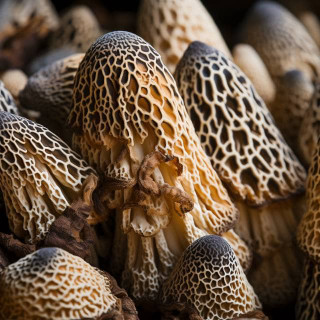
Complete Guide To Morel Mushrooms
You're about to embark on a journey into the world of Morel mushrooms. You'll learn their unique features, where they grow, and how to safely forage them. You'll delve into their taxonomy and understand their life cycle. Finally, you'll discover where to buy these culinary delights if you can't find your own. Let's unlock the mysteries of these gourmet fungi together!
Key Takeaways
- Morel mushrooms are highly prized for their unique flavor and texture.
- Proper identification is important to avoid poisonous look-alike mushrooms.
- Morels are commonly found in wooded areas, particularly near certain types of trees.
- Morels can be used in various culinary dishes and are considered a gourmet ingredient.
Introduction: Morel Mushrooms From Identification to Culinary Use
You're about to embark on a journey of discovering morel mushrooms, from learning how to identify them correctly to uncovering their unique culinary uses. "What is Morel?", Morels, belonging to the genus Morchella, are a prized delicacy known for their meaty texture and distinctive flavor. What is a morel? These fungi have an unmistakable honeycomb-like cap with hollow interiors that run throughout the stem, distinguishing them from other wild mushrooms.

Identifying morel mushrooms demands careful attention as they do have look-alikes which can be toxic if consumed. The key difference lies within; true morels are entirely hollow when sliced in half longitudinally while false ones show chambers or cottony fillings. So, always inspect your find before consumption.
Morels mushrooms are found across North America, Europe, and Asia typically during springtime when conditions are damp and warm. They grow well around dead and decaying trees making wooded areas a preferred hunting ground for these wild morel mushrooms.
Now onto what are morel mushrooms good for: In addition to being a gourmet food item savored by chefs worldwide, they also offer nutritional benefits like being low in fat and high in fiber and essential minerals. Cooking morel mushrooms is relatively simple yet rewarding; sautéed with butter or incorporated into risottos or pasta — every dish stands out owing to its rich nutty flavor profile. But remember never to consume raw morel mushrooms due to the presence of naturally occurring toxins that get neutralized only upon cooking.
With this foundation laid down on identifying and using Morels let's delve deeper into understanding the biology of these fascinating fungi in our next section: 'Understanding Morel Mushrooms'.
Understanding Morel Mushrooms: What Are Morel Mushrooms
Let's dive into understanding what these sought-after fungi are. Morel mushrooms, belonging to the Morchella genus, have an unparalleled reputation in the culinary world due to their unique nutty flavor and firm meaty texture. They are not your ordinary farmed portobello or oyster mushrooms; morels are primarily gathered from the wild each spring by enthusiasts and chefs alike.
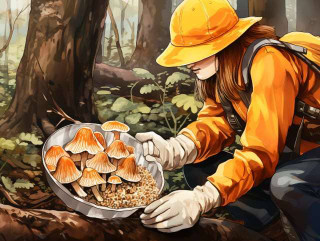
Now you might ask, how do morel mushrooms grow? These intriguing fungi live in a complex symbiotic relationship with trees. The edible part we relish is just the fruiting body of a larger underground structure known as mycelium.
Growing morel mushrooms isn't straightforward like regular farming, but it holds an immense fascination for mushroom cultivators. Here's where morel mushroom spores for sale come into play:
- You can purchase a morel mushroom growing kit.
- Opt for the best morel mushroom growing kit that suits your needs.
- Understand that cultivating them necessitates knowledge of their life cycle.
- Learn methods on how to stimulate growth under controlled conditions.
- Keep patience because yes, you can grow morel mushrooms but they require time and care.
Morels indeed pose a challenge even to seasoned mushroom growers due to their unpredictable nature. However, with scientific techniques and dedicated efforts, successful cultivation is possible.
Intriguing right? Now that we've grasped what are morel mushrooms and delved into their cultivation aspects let's move forward and explore key features for identifying these delicacies accurately in our next section 'Unmasking Morels: Key Identification Features'.
Key Features: How To Identify Morel Mushrooms
It's crucial to know how to identify morel mushrooms accurately, as mistaking them for toxic morel mushroom look alikes can have serious consequences. Morels, part of the Morchella genus, are distinct with their honeycomb-like caps and hollow interiors. When you cut a real morel lengthwise, it should be completely hollow from cap to stem. In contrast, poisonous false morels will have cotton-like stuffing inside.
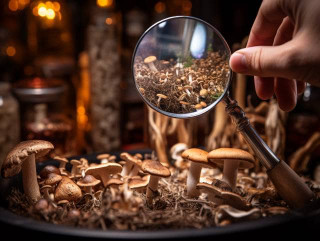
Examine pics of morel mushrooms closely; the unique ridges and pits on their caps make them stand out. Their colors range from light tan to dark brown. Be mindful that some variants called "half-free morels" have only part of their cap hanging freely from the stem – these can be trickier to identify.
While wild morrel mushrooms are prized finds for many foragers, don't rush into eating them raw. Eating uncooked morels may cause digestive issues as they contain certain toxins which are neutralized during cooking. Instead, learn how to cook dried morel mushrooms or fresh ones safely - sautéing in butter is a popular method.
Morels aren't just about safety precautions though; they're much sought after because of what they offer when cooked - an earthy, meaty flavor that enhances various dishes like pastas and risottos.
Now that you've got a better understanding of how to spot these gourmet fungi in the wild or even among 'morel spores for sale', your next question might be about where exactly you could find them thriving naturally. This brings us neatly toward exploring their preferred habitats and growth areas.
Habitats and Growth Areas: Where Do Morel Mushrooms Grow
Understanding where to locate these fungi in their natural habitat can significantly improve your chances of a successful forage. Morel mushrooms thrive near dying trees, such as elms and ash, feeding off the decaying root material. This is why morel landscaping often involves creating a similar environment.

Here are some key points to remember:
- Start by looking on the southern edge of trees, where the soil warms from the most sunlight exposure.
- Check under logs and hidden areas; interestingly, these might grow giant morels that remain moist while maintaining proper soil temperature.
- Monitor how fast do morels grow around an entire tree throughout the season as soil temperatures change.
- Black morels tend to appear first followed by "half frees", grays, yellows, or whites, and finally, giants.
- Burn areas often yield bumper crops for mushroom hunters; surprisingly, even after a forest fire or controlled burn, morel mushrooms may be among the first signs of life.
With patience and perseverance, you'll soon master how to grow morel mushrooms. Growing morel can be unpredictable but don't despair! There are various resources available like a morel mushroom kit that can guide you through cultivating morel mushrooms. Remember though it's not merely about asking 'Can I grow morel mushrooms' but understanding their specific growth cycle - knowing when they spawn and how fast do Morel mushrooms grow.
As your knowledge deepens on where you can find Morel mushrooms and how they flourish naturally will make your hunt much easier. Let's delve into 'the art of foraging: how to harvest Morel Mushrooms'.
The Art of Foraging: How to Harvest Morel Mushrooms
Harvesting these prized fungi isn't as simple as just yanking them from the ground; there's a certain art to it. You must understand the ecology of morels to increase your success in finding them. Morels have a symbiotic relationship with trees, particularly ash, elm, and poplar. They thrive in moist soil and areas that balance sunlight with shade.

Here's a brief table summarizing some essential tips:
| Tips | Purpose | Result |
|---|---|---|
| Use mesh bag or basket | To carry your harvests | Allows spores to spread |
| Cut or gently twist at base of stem | To avoid uprooting mycelium | Ensures future growth |
| Leave some behind | For others & wildlife | Sustainable harvesting |
After identifying the right habitat for finding morels, you need to know how to harvest morel mushrooms without damaging their delicate structure. Use a sharp knife, cutting just above where the stem meets the earth or gently twist at the base of the stem.
Having successfully harvested your bounty, you must know how to clean morel mushrooms properly. Shake them gently to dislodge any resident bugs or debris from its' honeycombed cap. Never soak your morels; instead lightly rinse under cool running water if necessary.
The next step is preparing morel mushrooms for consumption – remember you can eat morel mushrooms only when they're cooked thoroughly! Sautee in butter or olive oil until they're golden brown and crispy on the edges.
To store these delicious morsels for later use, dry them thoroughly before storing mushrooms in an air-tight container away from light and moisture.
Lastly, be aware that other forest inhabitants like squirrels also appreciate this tasty treat so ensure you don't leave any traces that might attract unwanted visitors.
Having honed your harvesting techniques let's delve into tips for staying safe during your mushroom hunting adventures.
Safety Tips: Avoiding Risks While Morel Mushroom Hunting
While you're out hunting for these elusive fungi, it's crucial to take certain precautions to ensure your safety. Morel mushroom hunting is an adventurous activity, but avoiding risks while mushroom hunting should be your top priority. To begin with, proper morel mushroom identification is the key. Understanding how to identify morel mushrooms can prevent you from picking and consuming poisonous look-alikes.
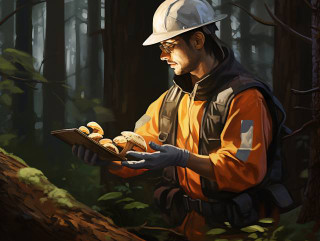
However, it is important to remain vigilant throughout your hunt.
- Wards off Insects and Ticks: Suit up in gear that can protect you from bug bites and ticks before setting out on your quest for morels. Use Bug Blocker sprays or similar repellents as they are quite effective. Ticks carry nasty diseases that could put a damper on your fun.
- Avoid Poison Ivy Patches: Wear long sleeves and pants to shield yourself from poison ivy which often grows near mushrooms. Camo or nature-colored gear helps maintain a low profile during your hunt, especially when mushroom spots are near popular areas.
- Navigate Burn Areas Safely: Burn areas present unique risks like ash pits, hazard trees, and tripping hazards such as exposed roots and remnants of burned trees.
- Cross-Check the Mushroom Characteristics: Use reliable references, and never eat a wild mushroom unless you're 100% sure about its identity.
Cleaning morel mushrooms is another aspect of morel mushroom safety. Learning how to clean morels properly can help remove any bugs or dirt trapped in their unique honeycomb structure before cooking.
Remember, each foraging trip brings its own set of challenges and rewards. As much as it's about locating these gourmet treasures, it's also about appreciating nature's bounty while taking necessary precautions during this exciting pursuit.
Now that we've covered safety tips for morel mushroom hunting and ensuring a rewarding experience, let's move forward on our journey by learning not just about finding but also cultivating these delightful delicacies yourself! The world of growing your own morels awaits - let's dive in!
A Step-by-Step Guide: How to Grow Morel Mushrooms
You're about to delve into the complex yet rewarding process of growing Morel mushrooms. We'll explore how to create a spore slurry, an essential step that involves suspending morel spores in water for propagation. From there, we'll discuss how to utilize growth kits for a more controlled cultivation environment and finally, we'll guide you through the process of inoculating trees - a technique that mimics the natural symbiotic relationship between fungi and their host trees.
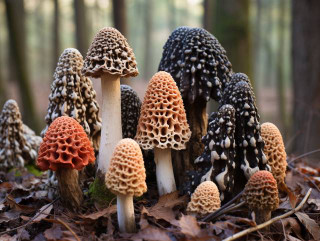
Make A Spore Slurry
It's possible to cultivate your own morel mushrooms using a spore slurry technique. With this method, you can grow morels right in your backyard. All it takes is some fresh morel mushrooms, a few common household items, and a bit of patience.
- You'll start by creating a mixture of non-chlorinated water, sugar, salt, and mushroom spores.
- Next, let the solution sit for one or two days at room temperature.
- Then pour the liquid over a suitable growing medium like wood chips or sandy soil.
- Finally, wait and watch as your very own morel mushrooms begin to sprout.
This not only allows you to enjoy fresh morel mushrooms whenever you want but also opens up opportunities for preserving them for later use or even selling them. Having learned how to grow from spores, let's talk about another exciting option: growing from kits.
Grow From A Kit
If you're not up for the challenge of growing from spores, there's another convenient option: purchasing a kit. These kits are designed to help you grow morel mushrooms with ease. They come with established mycelium, giving your mushrooms a better chance at growth.
| Grow From A Kit | |
|---|---|
| Pros | Simplifies process; Higher success rate |
| Cons | Not a free option; Less hands-on experience |
After harvesting, it's essential to know how to store fresh morels. Storing morel mushrooms properly can extend their freshness. The best way to store morel mushrooms is in a paper bag inside your refrigerator. If you have an abundance, consider dehydrating them. Dehydrated morel mushrooms retain their flavor and can be rehydrated when needed.
Next, let's explore how inoculating trees plays into this mushroom cultivation journey!
Inoculating Trees
Inoculating trees with morel spores or spawn can be an effective method for cultivating this prized fungus, though it does require patience as results often aren't seen for several years.
- You'll feel a sense of accomplishment when you see the first signs of growth.
- The anticipation and waiting period can be thrilling.
- Imagine the joy of harvesting your own home-grown morels.
- It's exciting experimenting with different ways to cook these gourmet mushrooms.
- There's something satisfying about knowing these nutritious fungi are from your backyard.
Drying morel or dehydrating morel mushrooms is one way to preserve their unique flavor. But how to dry morel mushrooms properly? And what about storing morels? Find out in the next section on 'keeping your morel mushrooms fresh: how to store morel mushrooms'.
Keeping Your Morel Mushrooms Fresh: How To Store Morel Mushrooms
You'll want to store your morel mushrooms properly to maintain their unique flavor and texture. Storing morel mushrooms in the fridge is a good short-term solution. Place them in a paper bag rather than plastic since they need to breathe, and avoid sealing them in any container. This is how you keep mushrooms fresh for about a week.

Here's a quick guide on how to store morel mushrooms:
| Prep Work Required | Purpose | Expected Shelf Life |
|---|---|---|
| Refrigeration | Store in paper bag/partially open ziplock | 1-2 weeks |
| Freezing (Blanched/Sautéed) | Blanch or sauté before freezing | Several months |
| Dehydration | Dry using dehydrator/oven/sunlight | Up to 1 year |
However, if you're wondering how to store mushrooms long-term, there are other methods you can use like freezing or drying them. Can you freeze morel mushrooms? Absolutely! To freeze morels, first clean and cut them into desired sizes. You can either blanch them before freezing or simply place raw pieces on a baking sheet lined with parchment paper and freeze them until firm before transferring them into freezer bags.
Another method for long-term storage is drying the wild morels. Simply string them up in a dry place out of direct sunlight or use a dehydrator if you have one. Dried morels can last for years when stored correctly.
Of course, all these methods depend on starting with high-quality, freshly harvested morels so be sure to check over your bounty carefully before beginning the preservation process.
Understanding how long do morels last under different storage conditions will help you maximize their shelf life without compromising quality or safety.
Next up: diving into what makes these fungi so sought after—their distinctive taste! Let's explore what do morel mushrooms taste like and why they're such an exciting find for food enthusiasts everywhere.
The Flavors of Morel Mushrooms: What Do Morel Mushrooms Taste Like
They're known for their earthy, nutty flavor, but describing the taste of these prized fungi isn't as simple as it seems. When you buy morels fresh and bite into them after a light sauté, your palate is greeted by an intricate symphony of flavors – sometimes sweet like honey or apricots, other times smoky with hints of almonds or hazelnuts.
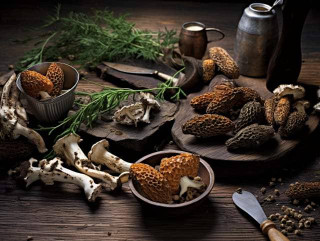
Fresh morels carry a robust profile that's enhanced when cooked. Before cooking these flavorful fungi, clean them thoroughly under cool water and dry them using a paper towel to maintain their texture. However, if you choose to alter morel by drying them out for later use, don't fret! If they are dehydrated morel mushrooms, rehydrate morel mushrooms in water before use and they'll be ready to add depth to your dishes while retaining their signature taste.
The flavors of morel mushrooms can vary depending on how you cook them:
- Sautéed Morels: These possess an earthy and nutty flavor with a subtly sweet undertone.
- Fried Morels: They reveal a savory flavor hinting at umami.
- Grilled Morels: Grilling imparts a robust smoky, earthy flavor complemented by charred notes.
- Boiled Morels: Boiling results in soft-textured morels with a mild taste.
When it comes to the best way to cook morel mushrooms, sautéing is often preferred due to its ability to retain moisture and prevent burning while enhancing the mushroom's inherent flavors. However, remember that the method chosen largely depends on personal preference.
More than just their incredible taste profile, these versatile little gems also pack quite the nutritional punch! They're high in protein and dietary fiber while being low in calories - making them a wholesome addition to any meal.
If you find fresh morel mushroom for sale at local markets or online outlets, don't hesitate! They're not only a culinary delight but also packed with health benefits from protein to fiber. Now let's explore how best we can utilize this versatile ingredient in cooking without compromising its complex flavor profile.
Culinary Uses: How To Cook Morel Mushrooms
So, let's dive into how you can incorporate these unique fungi into your meals. Morel mushrooms are renowned in the culinary world due to their distinct flavor and texture. Whether they're fresh, dried, or frozen, you've got a gourmet ingredient on your hands.
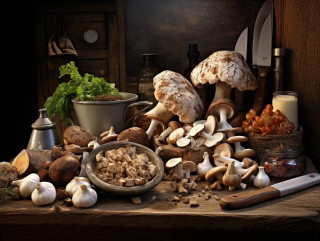
To cook morel mushrooms safely, it's crucial to clean them thoroughly first. This involves soaking morel mushrooms in salt water for about 20 minutes. The cleaning process helps remove any dirt and little critters hidden within their honeycomb-like structure.
When cooking fresh morels, begin by heating butter and neutral oil in a pan. Add your cleaned morels with some chopped shallots. Cook over low heat for around five minutes before deglazing the preparation with white wine or yellow wine and cooking for another five minutes.
If you're dealing with dried morels, rehydrate them before starting the same cooking process as above but use the morel rehydration water to baste regularly.
For frozen morels, thaw them out gently overnight in the fridge or speed up the process using a microwave before following similar steps used in cooking fresh ones.
Storing fresh mushrooms properly is essential as well to maintain their quality. Keep them loosely wrapped in paper towels inside a paper bag stored in your refrigerator's crisper drawer until it's time to cook them up!
Note that while these fungi are safe for human consumption when cooked properly, dogs should not eat morel mushrooms due to potential toxicity issues.
Equipped with this knowledge of how best to prepare morels for culinary uses let's shift gears slightly towards understanding their taxonomy: identifying different species of morels and spotting look-alikes.
Taxonomy: Morel Mushroom Look-Alikes and Species
It's crucial to understand the taxonomy of these prized fungi, as there are several species and look-alikes that you could encounter when foraging. Being able to correctly identify morel mushrooms is a sought-after skill, whether in Arizona or elsewhere. Morels have a unique appearance that can be likened to land fish or sponge mushrooms due to their distinctive honeycomb-like structure.
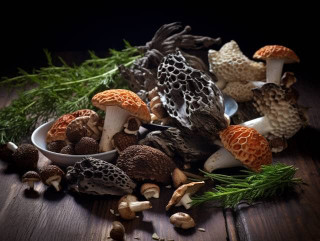
False morels are one such group of look-alikes you need to watch out for. They may appear like dry land fish mushrooms, but they're different and potentially toxic. It's essential to note the differences:
- True morels are completely hollow; false ones often have solid matter inside.
- The cap of a true morel is attached directly to the stem; false ones tend to have caps loosely attached.
- Morels' caps have a honeycomb pattern; false ones might have brain-like or wrinkled patterns.
- The color of true morel ranges from tan to dark brown; false ones can be orange or dark red.
Be aware of morel look-alikes and different species of poisonous mushrooms that may cause illness, as some can be harmful if ingested. This knowledge is crucial when you're out hunting for fresh morels or want to freeze morels for later use.
- False Morels: These mimic the true morel appearance but contain the specific toxin gyromitrin which turns into monomethylhydrazine (MMH) when ingested. You can distinguish them by their loosely attached caps, irregular shape, and dark color.
- Deadly False Morel (Gyromitra esculenta): Also known as brain mushroom, this poses one of the deadliest threats among morel look-alikes due to its high toxicity level.
- Early False Morel (Verpa bohemica): While it resembles true Morales mushrooms and is edible when cooked, caution should still be exercised.
- Bell Morel (Verpa conica): Known as the early morel or thimble fungus, this is edible after thorough cooking.
Understanding this distinction helps ensure your safety while foraging and allows you to enjoy these delicacies without worry. You can cook fresh morels immediately, or freeze them for later consumption - yes, freezing morrel mushrooms works perfectly fine! Dry morels too can be rehydrated before use.
Whether stumbled upon in your backyard or consciously sought after during a wilderness hike, it's always exciting spotting that unmistakable honeycomb shape nestled among leaves and twigs. Remember though, every find takes us closer not just towards savoring their unique taste but also towards understanding their intricate life cycle - an intriguing journey from spore germination to reproduction that we'll explore next!
The Morel Mushroom Life Cycle: Morel Mushroom Growth Stages
Understanding the life cycle of these sought-after fungi can elevate your foraging skills to the next level. Morel mushrooms don't just appear overnight; they undergo a slow, meticulous growth process that relies heavily on precise weather conditions. A gentle spring warm-up and sufficient moisture are key to their development.

In ideal conditions, morels won't grow more than an inch per day. Once they emerge, you might observe noticeable growth within 5-6 days. But remember, sudden cold snaps or lack of rain can hinder their growth dramatically.
Once you've mastered the art of finding these gourmet treats, knowing how to properly store mushrooms is essential. The best way to store fresh mushrooms is in a paper bag inside your fridge. This method allows them to breathe while maintaining their freshness longer.
If you want to keep mushrooms fresh even longer, consider drying them out completely before storing them. Dried morels have a shelf life of up to six months when stored in a cool, dark environment!
When considering the different species, it's worth noting that black morels often sprout first followed by gray and half-free varieties. Each type has unique characteristics like cap emergence and color changes which reflect its maturity stage.
Lastly, letting morels mature fully ensures maximum spore dispersal which contributes significantly to future harvests – another reason why understanding this lifecycle can be so beneficial!
With a comprehensive understanding of how to identify and preserve these wild delicacies successfully let's explore where you can buy premium-quality morel mushrooms if foraging isn't your cup of tea.
Purchasing Guide: Where to Buy Morel Mushrooms
If you're not up for foraging, there're several places where you can buy these tasty fungi. From local specialty stores that harbor a plethora of gourmet foods to farmers markets bustling with fresh seasonal produce, morels can be found if you know where to look. If in-person shopping isn't your style, numerous online retailers offer these delicacies.
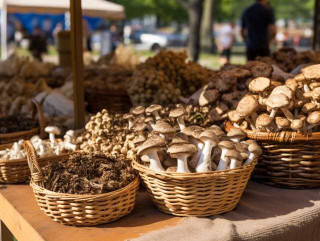
If you're looking where to buy morel mushrooms, there are several places you might want to consider.
- Local Specialty Stores: These stores often carry morel mushrooms among their gourmet offerings. Check out establishments like Whole Foods or Trader Joe's for fresh stock.
- Farmers Markets: Your local farmers market can be a goldmine for fresh morel mushrooms, especially during the spring and early summer months when they're in season.
- Online Retailers: If brick-and-mortar options fail, online retailers such as Foraged offer a convenient alternative, though shipping policies and pricing should be reviewed before purchase.
- Foraging: For those up to the task, morels can be found in moist woodland areas in North America, Europe, and Asia.
Once purchased, knowing how best to store mushrooms is crucial. Freshly bought morels should ideally be refrigerated as soon as possible in a paper bag which allows them some breathing space while absorbing excess moisture. Wondering how long can mushrooms sit out? Ideally, they shouldn't; prompt refrigeration ensures maximum freshness and longevity.
To make mushrooms last longer, consider drying them for long-term storage. They rehydrate beautifully when needed and their rich flavors intensify over time - arguably the best way to store mushrooms long term.
With this guide in hand on what is the best way to store mushrooms and whether they need refrigeration, you're now fully equipped to venture further into the world of these culinary gems - from understanding their unique growth stages to creating mouthwatering dishes with them! Onward then, let's master this enticing realm teeming with gastronomic delights!
Conclusion: Mastering the World of Morel Mushrooms from Identification to Culinary Delights
You've journeyed from identifying these unique fungi to purchasing, storing, and finally preparing them for culinary delight. As you now know, morel mushrooms are a gastronomic treasure with their distinct woodsy flavor and spongy texture. When cooked right, they transform into tender, juicy morsels filled with nutrients. But remember that mastering the world of morels requires understanding their biological nature and being aware of where to source the best specimens.
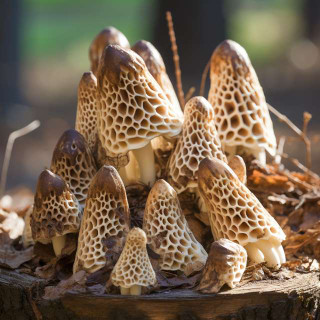
| Species Specs | Pros | Cons |
|---|---|---|
| Unique spongy texture | Versatile in various dishes | Can be tricky to cook properly |
| Woodsy flavor | Excellent source of nutrients | Requires careful storage to maintain quality |
| High in nutrients | Unique rich and earthy taste | Prices can be high due to seasonal availability |
Explore the Secrets of Growing Morel Mushrooms
Ever wondered about growing morel mushrooms? FunGuy Mushroom Supply has everything you need, from grain spawn bags to complete mushroom kits. Explore now and start your morel adventure! Browse Our Inventory.
Frequently Asked Questions

How to keep morels fresh?
You're probably wondering how to keep those freshly picked gems fresh for as long as possible, aren't you? Preserving morel mushrooms can be a bit of a challenge, but it's certainly doable. The best way to keep mushrooms fresh is by storing them properly.
| Storage Method | Key Steps | Tips |
|---|---|---|
| Refrigerate Mushrooms | Keep your morels in a brown bag or bowl covered with a damp paper towel. | Do not wash the morels until you're ready to use them. They are best eaten within four days of picking. |
| Dry Morels | Hang morels on a string in your kitchen, leaving space between each one for adequate airflow. | Ensure they are dry before storing in an air-tight jar kept in a cool, dark place. No need to wash before drying! |
| Freeze Morels | Slice and sauté your morels before freezing them flat on cookie sheets and transferring them into freezer bags. | This helps maintain their flavor and texture for longer periods. |
How to store morels overnight?
If you've got a bounty of these tasty fungi and need to store them overnight, it's crucial to ensure they're kept in optimal conditions for freshness. The question of how to store morels for a few days can be answered with some simple steps.
Start by storing morel mushrooms in the fridge, as this is the best way to keep them fresh. Wrap your morels in paper towel and place them uncovered in a bowl inside your fridge; this allows air circulation which prevents moisture buildup that could lead to mold.
The best way to store mushrooms in the fridge is by not sealing them completely. Morels need some breathing space, so don't pack them too tightly or use an airtight container.
Remember, how you store morel mushrooms plays a big role in their longevity and taste. To extend their life even further and keep mushrooms fresh longer, consider longer-term storage methods such as freezing or drying after their short stint in the refrigerator.
Now that we've covered how to store fresh mushrooms in the fridge overnight let's explore other ways you can preserve morels for extended periods without losing any of that delicious flavor.
How to store morels for a few days?
Storing morels for a few days isn't too tricky, and there're several methods you can use to keep them fresh. One of the best ways to store wild mushrooms is by placing them in a brown bag or bowl, covering them with a damp paper towel, and then refrigerating them. The cold temperature and moisture helps keep the mushrooms fresh and prolong their shelf life.
So, do mushrooms need to be refrigerated? Absolutely! Refrigerating morels slows down the process of decay that naturally occurs in fungi. Should you refrigerate mushrooms immediately after picking? Yes, mushrooms should be refrigerated as soon as possible.
But how long do morel mushrooms last exactly? If stored properly using this method, your morels should stay good for about five days. To ensure optimal freshness during mushroom storage, check on your morels daily for any signs of spoilage such as mushiness or an off smell.
Remember that proper storage is key when figuring out how to best store mushrooms. So now that you know how to keep mushrooms fresh short term, it's time to learn about long-term options. Let's delve into how you can store morel mushrooms over extended periods without compromising their quality or taste.
How to store morel mushrooms long term?
When it comes to keeping those prized fungi for longer periods, there're a few techniques that can come in handy. If you're wondering how to store morel mushrooms long term, look no further. Preserving mushrooms starts with temperature control; cool environments are crucial. As for humidity, keep your morels dry to prevent moisture buildup.
Airflow is essential as well: let your morels breathe to avoid mold growth. Light exposure should be minimal; dark areas help preserve their unique flavor. And remember, contamination from strong-smelling foods can alter the taste of your morels.
The freezer is a great long-term storage option and freezing morel mushrooms maintains both texture and flavor remarkably well. Start by cleaning and slicing the morels in half lengthwise. Arrange them on a baking tray and flash freeze before transferring them into freezer-safe containers or bags.
Another effective method involves drying out the mushrooms completely using a food dehydrator or an oven set at a low temperature (around 140°F). Once dried, these can be stored in an airtight container indefinitely.
Now that you know the best ways to preserve mushrooms let's delve into what you might do with those mouth-watering morels post-picking!
What to do with morel mushrooms after picking?
You've successfully harvested some wild fungi, now let's talk about the exciting things you can do with them in your kitchen. The realm of what to do with morel mushrooms is extensive and delightful; these earthy delights lend themselves to a plethora of culinary applications.
First, ensure you know how to wash morels properly. Rinse gently under cool water and use a soft brush or cloth to remove any visible dirt. Next comes preparation; you can slice them into halves or quarters, depending on their size.
As for cooking, sautéing these wild mushrooms in butter brings out their unique flavor. Try adding them to risotto or pasta for an exquisite touch. To store cut mushrooms effectively, wrap them in paper towels and keep them in an open container inside the fridge – this allows them to breathe while preventing moisture buildup.
When it comes to preserving these treasures long-term, drying is a common method used by many fungi enthusiasts. This not only extends their shelf life but also intensifies their flavor profile - making dried morels a highly sought-after ingredient in gourmet recipes.
Stay tuned as we delve further into ways how to preserve morel mushrooms for future use!
How to preserve morel mushrooms?
After you've successfully foraged and identified your morel mushrooms, the next challenge is preserving them. You might be wondering how to keep them fresh without a fridge or maybe you're considering storing sliced mushrooms. Here are four methods:
- Refrigeration: Do you refrigerate mushrooms? Yes! Morels can be stored in a paper bag and placed in the fridge for up to one week.
- Freezing: Can you freeze morels? Absolutely! First, blanch them quickly in boiling water, then shock them in cold water before freezing.
- Drying/Dehydrating: Another great option is to dehydrate morel mushrooms. They can be air-dried or dried using a dehydrator and then stored in an airtight container for future use.
- Pickling/Canning: This process involves immersing the morels in vinegar or brine solution and sealing them tightly in jars.
Each method has its advantages, but consider your culinary plans when deciding how to preserve your prized fungi collection. Now that we've addressed several preservation options, let's delve deeper into one of the most frequently asked questions: How do you freeze morels?
Can you freeze morel mushrooms?
Sure, you can freeze morel mushrooms and it's one of the best ways to preserve their unique flavor and texture. After a successful foraging trip or buying spree at the farmer's market, if you're wondering "Can you freeze morel mushrooms?" the answer is a resounding yes! Freezing not only helps maintain these fungi's distinctive qualities but also extends their shelf life significantly.
However, before freezing them, it's essential to clean your morels meticulously. Dirt and small insects often hide in their honeycomb-like cap structure. Once cleaned properly, consider how do you want to use them later? If using dried morel mushrooms is your preference, dry them out before freezing.
| Method | Advantages | Disadvantages |
|---|---|---|
| Freezing Morels | Preserves taste and texture; Long shelf life | Requires freezer space |
| Drying Morels | Shelf-stable; Intense flavor when rehydrated | Loses some texture |
| Storing Fresh Morels | Immediate use; Full flavor & Texture | Short shelf life |
How to freeze morel mushrooms?
It's crucial to know the right way to freeze these tasty fungi for later use. Morel mushrooms require careful handling and storage, and you can't eat them raw due to their toxic compounds when uncooked. Here are four steps in freezing morels:
- Clean your freshly picked or cultivated morels well by soaking them in salt water for a while (how long to soak morels depends on their size).
- Boil clean morels until the water returns to boiling point. This not only cleanses but also begins the rehydration process.
- Lay out the boiled morels on paper towels, allowing them ample time to dry.
- Once dried, freeze them in freezer bags arranged in single layers.
Freezing is an ideal method if you've had a successful season growing morel mushrooms either through wild foraging or home cultivation methods - 'Can you grow morel mushrooms?' Yes indeed! You'll be able to enjoy your favorite mushroom dishes all year round with your frozen stash of delectable treats.
Now that we've covered how best to store your precious fungi haul, let's move on to another common question: Do mushrooms need refrigeration?
Do mushrooms need to be refrigerated?
After successfully freezing your morel mushrooms, you might be curious about the best way to store fresh ones. Well, due to their high water content, it's best to refrigerate morels. They can stay on your counter for a day or so but for optimum freshness and longevity, place them in the fridge.
Before storing though, cleaning morels is crucial as they often harbor little critters like morel mushrooms worms. Soak them briefly in saltwater – this process helps get rid of any hiding morel worms.
| How long to soak Morels? | Action Against Morel Worms? | |
|---|---|---|
| 10-15 minutes | Kills & dislodges worms |
But remember, soaking them too long can make them soggy. The question 'How long to soak morel mushrooms in saltwater?' is crucial – 10-15 minutes should suffice.
Enjoy your fresh and clean morells mushrooms, ready for culinary masterpieces! Selling morel mushrooms? Keep these tips in mind for quality produce that fetches good prices.
Now that we've covered proper storage let's move on to understanding how long do these delicious fungi last once they're out of their natural habitat.
How long do morel mushrooms last?
You're probably wondering about the shelf life of these prized fungi once they've been harvested, aren't you? Well, in this complete guide to morel mushrooms, we'll address exactly how long do morel mushrooms last.
- Freshness: Freshly harvested morels can last for up to three days in the fridge if stored properly. However, their unique flavor and texture are best enjoyed as soon as possible after picking.
- Drying: You can extend their shelf life by drying them out completely; dried morels can last indefinitely when stored in a cool, dark place.
- Cooking: Once cooked, dishes featuring morels should be eaten within two days for optimal taste.
While dogs shouldn't eat any kind of mushrooms due to their sensitive digestive systems, some animals like squirrels and slugs do enjoy nibbling on these fungi. Morel hunting is a popular pastime during spring; you can find these gems hidden under leaf litter near dying trees or disturbed ground. Furthermore, growing your own is possible but requires patience and specific conditions.
Curious about how much do morel mushrooms sell for? Owing to their rarity and unique taste, they fetch high prices - often between $20-$40 per pound!
Now that you know all about the lifespan of these delicious morsels let's move on to how best to store your harvest before it hits the pan!
How to store morels before cooking?
Storing your freshly picked fungi properly is crucial for maintaining their unique flavor and texture. This is particularly true when dealing with morels, as these delicate morsels can lose their delectable taste if not stored correctly.
If you've been on a successful hunt in your backyard for mushrooms that grow in mulch or have managed to identify some fresh morels using Arizona mushroom identification techniques, make sure you store them right. Avoid the temptation to stash away your loot. Morels are best consumed within four days of picking.
Here's a quick guide:
| Storage Method | Duration | |
|---|---|---|
| Fridge (in a brown bag) | 4 days | |
| Fridge (bowl + damp paper towel) | 5 days |
Remember, hoarding morels won't do you any good. If unused within five days, they're history! So whether it's mulch mushrooms or luxurious morels from your latest foraging expedition, proper storage ensures optimum freshness and taste.
Now that we've covered how to store your treasured finds properly, let's move on to learn about an essential preparatory step: soaking the morel mushrooms in saltwater.
How long to soak morel mushrooms in saltwater?
Before cooking those prized fungi, it's crucial to know that they should be soaked in saltwater for about twenty minutes to ensure they're clean and ready to use. This helps remove any dirt or debris hidden within their unique honeycomb structures.
Here are four primary steps you need to follow:
- Rinse your morel mushrooms under cold water.
- Slice them in half lengthwise; this not only allows for thorough cleaning but also makes the soaking process more effective.
- Soak them in a bowl of saltwater, ensuring all parts are submerged.
- After about twenty minutes, drain the water and gently pat the mushrooms dry with a clean towel.
Remember, cleanliness is paramount when preparing these earthy delicacies. Morels have an intricate structure that can harbor tiny insects or particles of soil that could affect your culinary experience negatively.
The delicate flavor of morels is highly prized in gourmet cooking worldwide so don't let minor impurities spoil your feast! Now you might be wondering if there's a way you can grow these culinary gems yourself – well, let's delve into that next!
Can you grow morel mushrooms?
It's certainly challenging to cultivate these prized fungi at home, but with the right conditions and a bit of patience, you might just be successful! Morel mushrooms are known for their finicky nature and specific growth requirements. They thrive in outdoor environments that mimic their natural habitat - think moist soil, ample sunlight filtered through trees, and an abundance of decaying organic matter.
Unlike plants, morels don't grow from seeds; they sprout from microscopic spores. This means that to grow morels at home, you'll first need to obtain a spore or spawn kit. However, remember that growing morels indoors is nearly impossible without strict laboratory conditions and equipment.
The real key to success lies in replicating the outdoor environment as closely as possible. That includes maintaining proper temperature ranges (around 50-60°F), providing plenty of moisture without waterlogging your substrate, ensuring good air circulation while avoiding direct wind exposure, and offering a food source like wood chips or straw for the fungus to consume.
Now that you're armed with this knowledge about growing morel mushrooms at home let's delve deeper into understanding how this process works.
How to grow morels?
You're in for a challenge when attempting to cultivate these fungi but don't worry, we'll walk you through the steps. Morels are known for their pickiness and require very specific conditions to grow successfully.
- Obtain morel mushroom spores or spawn: Harvest spores from a foraged morel or purchase them online. You can also create a spore slurry by boiling water with molasses and salt, adding pieces of morel, then straining the mixture.
- Select the perfect site: Morels thrive on forest floors among deciduous trees. They prefer filtered sunlight and loamy soil enriched with decaying wood. Consistent moisture is crucial, so choose an area that maintains good hydration but isn't waterlogged.
- Prepare your soil: Add compost or wood ash to improve its fertility and structure. These additions mimic the natural environment of morels, boosting your chances of success.
- Maintain your site: Keep an eye on the temperature as cool conditions are preferred by these mushrooms while harsh cold or intense heat might be detrimental.
References
- Du, X. H., Zhao, Q., & Yang, Z. L. (2015). A review on research advances, issues, and perspectives of morels. Mycology, 6(2), 78–85. https://doi.org/10.1080/21501203.2015.1016561
- Bell, V., Silva, C. R. P. G., Guina, J., & Fernandes, T. H. (2022). Mushrooms as future generation healthy foods. Frontiers in nutrition, 9, 1050099. https://doi.org/10.3389/fnut.2022.1050099
- Tietel, Z., & Masaphy, S. (2018). True morels (Morchella)-nutritional and phytochemical composition, health benefits and flavor: A review. Critical reviews in food science and nutrition, 58(11), 1888–1901. https://doi.org/10.1080/10408398.2017.1285269
- Sunil, C., & Xu, B. (2022). Mycochemical profile and health-promoting effects of morel mushroom Morchella esculenta (L.) - A review. Food research international (Ottawa, Ont.), 159, 111571. https://doi.org/10.1016/j.foodres.2022.111571
- Tietel, Z., & Masaphy, S. (2018). True morels (Morchella)-nutritional and phytochemical composition, health benefits and flavor: A review. Critical reviews in food science and nutrition, 58(11), 1888–1901. https://doi.org/10.1080/10408398.2017.1285269

